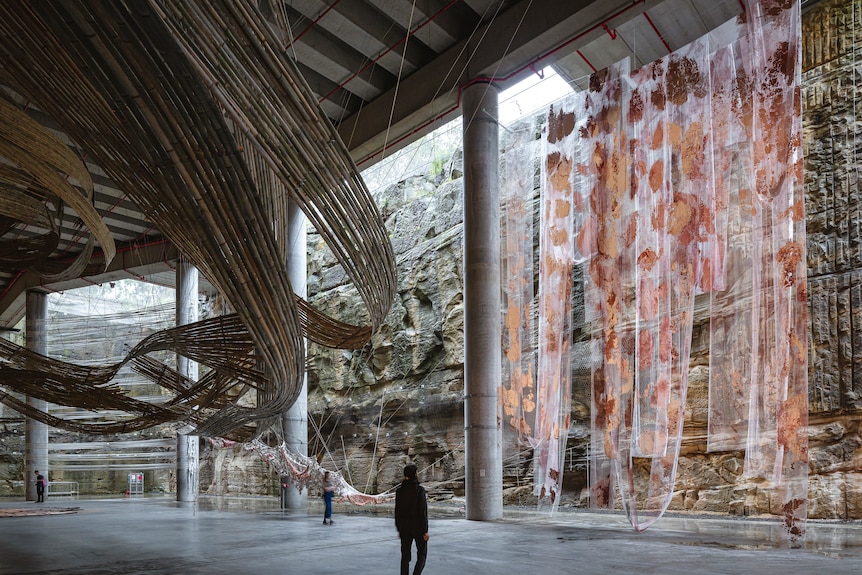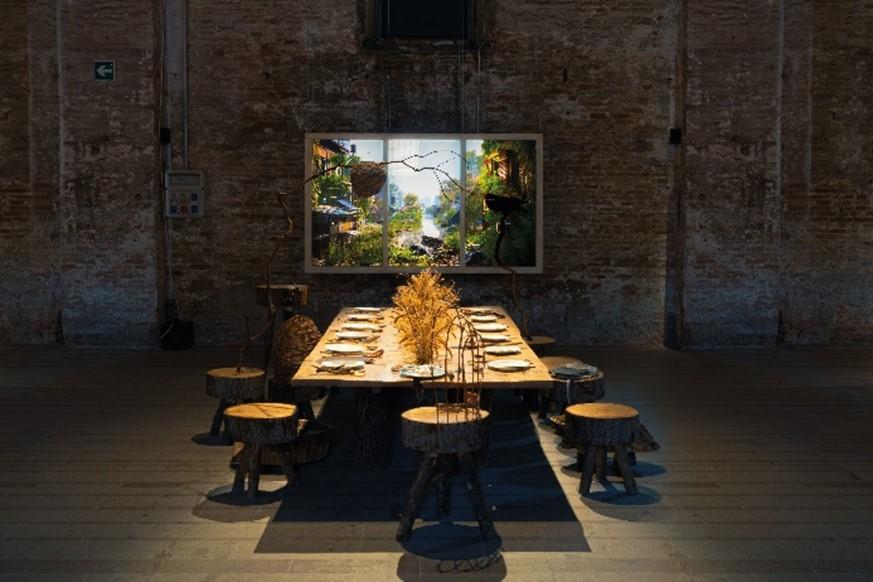Like the jellyfish and algae proliferating in the Venetian lagoon underneath this year’s Biennale (read our article on the 2022 Venice Biennale here), the number of exhibitions on environmental issues, more thankfully, continues to grow. In particular, water and marine ecosystems are the subject of numerous new biennales, shows, and art spaces. Back on land, the USA is seeing a revival of the Land Art movement, whereas institutions in London and the UK, already the home of important art-led activists movements such as Climate Declares Emergency, are committing ever more to environmental advocacy, including major upcoming exhibitions at the Royal Academy of Arts and the Barbican.
UNCHARTERED WATERS

Installation view, 23rd Biennale of Sydney, rīvus, 2022, The Cutaway at Barangaroo.
Water covers about 71% of the earth’s surface, but only now does it seem to be getting a proportionate attention.
As extreme flooding hits the coast of Sydney, Australia, the city has fittingly opened a 23rd edition of the Sydney Biennale (12 March – 13 June) on the theme of rivers, wetlands and other salt and freshwater ecosystems. Entitled “rīvus”, the biennale seeks to give agency to these living systems by posing the question: “If we recognised them as individual beings, what might they say?” Eight of the participants in the Biennale are in fact rivers (including the Vilcabamba and Napo rivers in Ecuador; and the Baaka/Darling river in Australia), acknowledging the global movement to recognise the rights of nature.
The Toronto Biennale “What Water Knows, The Land Remembers” (26 March – 5 June) itself takes as a starting point its location alongside the Great Lakes, the world’s largest fresh water system, to explore the fact that water is an archive of all the earth’s activity, from the past until the present day. For example, Susan Schuppli’s “Learning from Ice” (2019-ongoing) presents a documentary film that examines the ecosystem of ice, the cryosphere and its inhabitants to bring a deeper awareness of the effects of global warming.
In “Waters’ Witness”, at the Fundação de Serralves – Museum of Contemporary Art, Porto, Portugal (24 Feb – 28 Aug), artist Tarek Atoui invites us to sense the industrial, human and ecological activities of various port cities — Athens, Abu Dhabi, Singapore, Beirut and Porto – through sounds recorded in each location, transmitted through sourced materials, such as marble stones or organic matter.
Meanwhile, in Delft, Netherlands, a new centre for contemporary art and ecology, Radius, opens on May 8th in the pump house and water basin belonging to the Delft water tower, a historical monument and architectural landmark. The 500m2 of subterranean exhibition space will be unveiled with “Emotions are Oceans”, presenting the work of 19 artists, including Ursula Biemann, and Josèfa Ntjam, all of whom explore the global water crisis.
AMERICAN BLOCKBUSTERS

Christopher Ciccone/Courtesy North Carolina Museum
In the US, at the North Carolina Museum of Art, an Oscar-worthy list of artists address environmental issues in “Fault Lines: Art and the Environment” ( 2 April –17 July), including John Akomfrah, Olafur Eliasson, Allison Janae Hamilton and Richard Mosse. The artists’ works weave both inside and outside of the museum and its impressive sculpture park, which have won international acclaim for innovative approaches to energy-efficient design.
The Madison Museum of Contemporary Art (MMoCA), in Wisconsin, itself goes back in time with its own retrospective of eco-art pioneer Mel Chin. Famous for his land art project Revival Field (1990), “Mel Chin: There’s Something Happening Here” (12 Mar – 31 July) displays 43 years of the artist’s work that testify to his commitment to the intersection of art with social, political, and environmental justice.
Bringing land art back to the present day is new space The Elemental in Palm Springs, California. The inaugural exhibition “The Gaia Hypothesis – Chapter One : Earth, Fire, Water, Air” (13 Feb – 1 May) features seminal artists of 1970’s Earth Art, such as Helen Mayer and Newton Harrison and Ana Mendieta, in combination with a new generation of artists, such as Angelika Markul (who also has a new exhibition at Kewening gallery, Berlin). The art centre, connected to the Paris-based Fondation LAccolade, will also host nomadic artist residences in relation to the surrounding landscapes of the deserts of the great American West.
At Frederik Meijer Gardens and Sculpture Park (Grand Rapids, Michigan), Yinka Shonibare CBE presents work from the past three decades, many of which have never been shown in the US, among them sculptures, paintings, photographs, collages, embroidery, and film. The show is entitled “Planets in My Head” (April 1 – Oct 23 2022).
Finally, looking at the gallery scene, it’s worth mentioning two major shows: Mark Dion presents four new sculptural works and over a dozen drawings for his exhibition “Mark Dion: Theater of Extinction” at Tanya Bonakdar Gallery in Los Angeles (April 9 – May 25 2022) and John Gerrard presents “washington.streams” at von ammon in Washington (May 7 – June 19).
LONDON CALLING

Our Time on Earth, Barbican Curve – Refuge for Resurgence, Superflex (Biennale Architettura, La Biennale di Venezia, 2021. @ Giorgio Lazzaro)
On the other side of the Pacific Ocean, London’s Barbican Centre returns to the subject of environment, over 10 years since the institution’s landmark exhibition “Radical Nature” in 2009. Curated by futures research agency FranklinTill, “Our Time on Earth” (5 May–29 Aug 2022) is interesting for incorporating a multidisciplinary and collaborative approach that brings together academics, architects, artists, activists, designers, ecologists, engineers, environmental campaigners, researchers, scientists, technologists and writers from 12 countries around the world. One highlight includes “Queer Ecology”, a digital artwork made by Colombian biologist Brigitte Baptiste and the Institute of Digital Fashion (IoDF), that connects the fight for climate justice and LGBT rights with an illustration of nature’s gender fluidity. Another is “Wither”, an immersive, digital representation of rainforest destruction created by Dutch artist Thijs Biersteker in collaboration with UNESCO – Man and the Biosphere programme, a collaboration initiated in 2021 by Art of Change 21* for the exhibition “Biocenosis21” held at the IUCN World Conservation Congress in Marseille.
Last but not least, the Royal Academy has chosen the theme of “Climate” for its famous Summer Exhibition (June 21 – Aug 21), an annual artist open call founded in 1768. We look forward to seeing what ideas will emerge out of the 1000 works that will make up the final selection. With the environmental crisis looming, wider participation is key. Initiatives such as these make us hopeful that change is closer than we think – and perhaps great art can show us the way.
OTHER NOTABLE MENTIONS:
- For those heading to the Venice Biennale, it’s worth making time to head north to the lesser known Biennale Gherdëina (20 May – 25 Sep). Based in the natural beauty of the Dolomite mountains in Italy, it celebrates the multitude of living forms – human, animal, vegetal, mineral, or mycological – that populate this area “through exhibitions, encounters, performances, songs, storytelling, hugs, books and other streams of exchange”. This year’s edition “Persones Persons” is co-curated by Lucia Pietroiusti and Filipa Ramos, and includes artists such as Etel Adnan, Chiara Camoni, Alex Cecchetti, Jimmie Durham, and Karrabing Film Collective.
- ARoS Museum, in Aarhus, Denmark, opens Vertigo, an exhibition that attempts to reflect the sense of unease that emerges out of this time of unpredictability and dramatic change, featuring works by Cao Fei, Jeremy Shaw, and Julian Charriére (9 April – 11 Sep 2022).
- Michael Wang presents “Lake Tai” at Prada Rong Zhai, Shanghai, with a series of sculptures and installations that look at the natural and cultural heritage of the Lake Tai region, interrogating the pollution and consequent reclamation efforts that have shaped the lake and river in recent years.
- A new exhibition by Katie Paterson “Requiem”, at the Ingleby Gallery, Edinburgh, recounts the birth and life of our planet through a single object, which incorporates dust dating from pre-solar times through to the present (9 April – 11 June 2022).
Author: Stefano Vendramin
April 2022
*publisher of this blog
Find here all the articles from Impact Art News n°37 April / May 2022
The next in this series of articles will be on exhibitions in France and will appear in June/July issue 2022.
Subscribe to Impact Art News (free): here
Exhibitions:
Biennale of Sydney – 23rd Biennale of Sydney – Rīvus, Sydney, Australia, 12 March – 13 June 2022
What Water Knows, The Land Remembers, Toronto Biennale of Art, Toronto, Canada, 26 March – 5 June 2022
Waters’ Witness, Fundação de Serralves – Museum of Contemporary Art, Porto, Portugal, 24 Feb – 28 Aug 2022
Underland Chapter 1: EMOTIONS ARE OCEANS, Radius CCA, Delft, Netherlands, 08 May – 26 June 2022
Fault Lines: Art and the Environment, North Carolina Museum of Art, USA, 2 April –17 July 2022
Mel Chin: There’s Something Happening Here, The Madison Museum of Contemporary Art (MMoCA), USA, 12 March – 31 July 2022
The Gaia Hypothesis – Chapter One : Earth, Fire, Water, Air, The Elemental, Palm Springs, California, 13 Feb – 1 May 2022
Angelika Markul: La memoire des glaciers, KEWENIG, Berlin, Germany, 28 April – 2 Jul 2022
Yinka Shonibare CBE: Planets in My Head, Frederik Meijer Gardens and Sculpture Park, USA, April 1 – Oct 23 202
Mark Dion: Theater of Extinction, Tanya Bonakdar Gallery, Los Angeles, USA, April 9 – May 25, 2022
John Gerrard: washington.streams, von ammon, Washington, May 7 – June 19 2022
Our Time on Earth, Barbican Centre, London, UK, 5 May – 29 Aug 2022
Summer Exhibition 2022, Royal Academy, London, UK, June 21 – Aug 21 2022
Biennale Gherdëina: Persones Persons, Val Gardena, Italy, 20 May – 25 Sep 2022
Vertigo, ARoS, Aarhus, Denmark, 9 April – 11 Sep 2022
Lake Tai, Prada Rong Zhai, Shanghai, 8 April – 5 June 2022
Requiem, Ingleby Gallery, Edinburgh, UK, 9 April – 11 June 2022
Cover: Noise Aquarium will be on display at in Our Time on Earth, Barbican, London AQUARIUM, Victoria Vesna / Angewandte Scientific Visualization Lab, 8K Deep Space, Ars Electronica. Linz, Austria 2018. photo: Glenneroo

